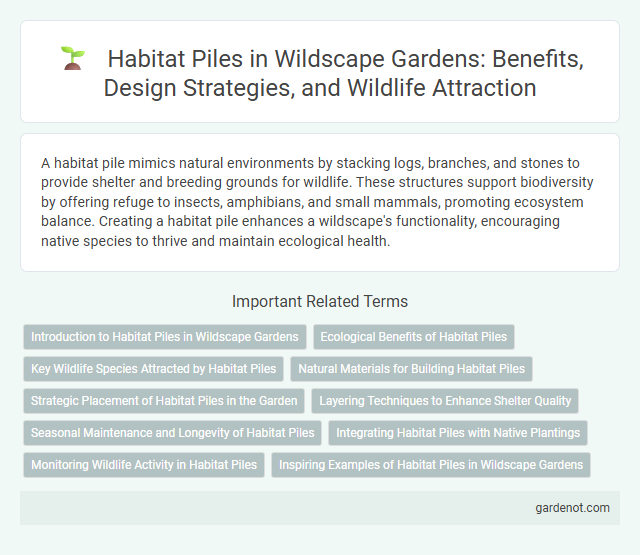A habitat pile mimics natural environments by stacking logs, branches, and stones to provide shelter and breeding grounds for wildlife. These structures support biodiversity by offering refuge to insects, amphibians, and small mammals, promoting ecosystem balance. Creating a habitat pile enhances a wildscape's functionality, encouraging native species to thrive and maintain ecological health.
Introduction to Habitat Piles in Wildscape Gardens
Habitat piles in Wildscape Gardens create essential microhabitats that support diverse wildlife by mimicking natural environments. These piles consist of layered organic materials such as logs, branches, leaves, and stones, fostering shelter and breeding sites for insects, amphibians, and small mammals. Incorporating habitat piles enhances biodiversity and ecological balance, making them a cornerstone of sustainable garden design.
Ecological Benefits of Habitat Piles
Habitat piles provide essential shelter and breeding grounds for various wildlife species, promoting biodiversity in natural ecosystems. These structures enhance soil fertility by facilitating decomposition and nutrient cycling through organic matter accumulation. By supporting insect populations and small mammals, habitat piles contribute to balanced food webs and overall ecological resilience.
Key Wildlife Species Attracted by Habitat Piles
Habitat piles attract key wildlife species such as small mammals, amphibians, and various insect species by providing shelter and breeding grounds. Species like hedgehogs, toads, and beetles utilize these piles for protection from predators and harsh weather conditions. These habitat structures contribute to biodiversity by supporting essential ecosystem functions through the presence of these wildlife species.
Natural Materials for Building Habitat Piles
Habitat piles constructed with natural materials like dead wood, bark, leaves, and twigs create essential microhabitats that support biodiversity. These organic components provide shelter, nesting sites, and food sources for a range of wildlife including insects, amphibians, and small mammals. Utilizing locally sourced natural materials enhances ecological balance and promotes sustainability in wildscape habitat management.
Strategic Placement of Habitat Piles in the Garden
Strategic placement of habitat piles enhances biodiversity by creating microhabitats that support insects, amphibians, and small mammals within the garden ecosystem. Positioning piles near water sources and under native vegetation maximizes shelter and breeding opportunities for wildlife, promoting ecological balance. Integrating habitat piles in shaded, undisturbed corners encourages natural decomposition processes and enriches soil health.
Layering Techniques to Enhance Shelter Quality
Habitat piles benefit greatly from precise layering techniques that combine logs, branches, leaf litter, and soil to create insulated microhabitats supporting diverse wildlife. Strategic placement of coarse woody debris at the base ensures moisture retention and structural stability, while finer material layers on top improve thermal regulation and provide refuge from predators. This multi-tiered approach enhances shelter quality by mimicking natural forest floor complexity, promoting biodiversity and ecosystem resilience within wildscapes.
Seasonal Maintenance and Longevity of Habitat Piles
Seasonal maintenance of habitat piles involves regular monitoring to ensure structural integrity and removal of debris that may hinder wildlife sheltering. Proper upkeep extends the longevity of habitat piles by preventing moisture buildup and promoting natural decay cycles that sustain biodiversity. Implementing periodic inspections during spring and fall supports optimal habitat conditions for species relying on these shelters.
Integrating Habitat Piles with Native Plantings
Habitat piles provide essential shelter and breeding sites for native wildlife while promoting biodiversity in natural environments. Integrating habitat piles with native plantings enhances ecological connectivity by creating microhabitats that support pollinators, small mammals, and amphibians. Strategically placing these piles near native shrubs and grasses maximizes habitat complexity and contributes to the restoration of local ecosystems.
Monitoring Wildlife Activity in Habitat Piles
Habitat piles serve as crucial shelters for small mammals, reptiles, and insects, making them hotspots for biodiversity within wildscapes. Monitoring wildlife activity in habitat piles involves using motion-activated cameras and tracking devices to gather data on species presence and behavior patterns. This information supports conservation efforts by identifying key habitats and assessing ecosystem health in real-time.
Inspiring Examples of Habitat Piles in Wildscape Gardens
Habitat piles in Wildscape gardens create essential refuges for native wildlife, incorporating diverse materials like logs, stones, and leaf litter to simulate natural environments. These piles enhance biodiversity by providing shelter and breeding sites for insects, amphibians, and small mammals, fostering ecosystem balance. Notable examples include layered wood and brush piles that encourage pollinators and decomposers, demonstrating effective conservation through naturalistic garden design.
Habitat pile Infographic

 gardenot.com
gardenot.com